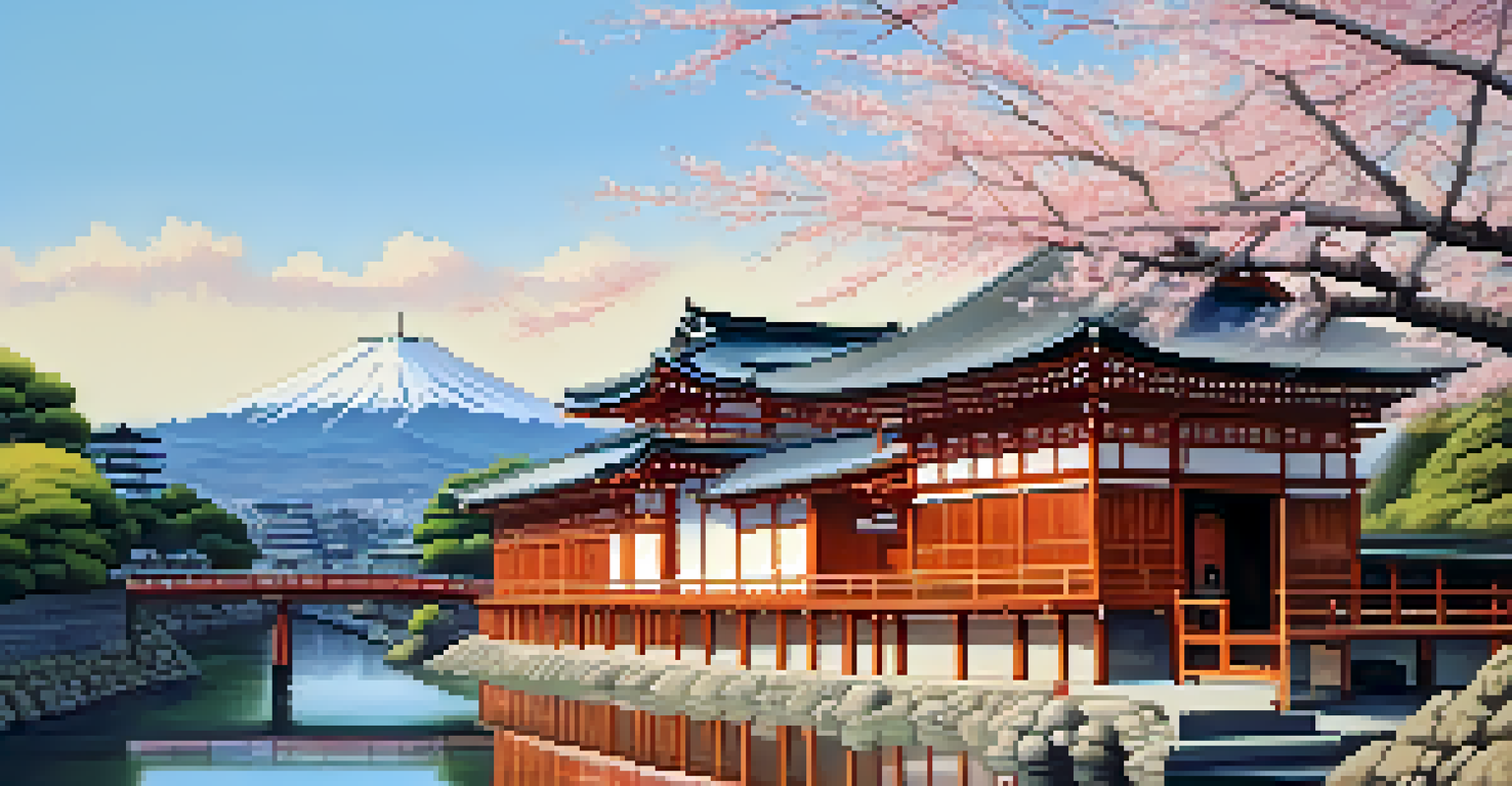Japan's Hanami Festival: Tradition of Cherry Blossom Viewing

What is Hanami? Understanding the Cherry Blossom Tradition
Hanami, which translates to 'flower viewing,' is a beloved Japanese tradition where people gather to enjoy the beauty of cherry blossoms in bloom. This practice dates back over a thousand years and has deep cultural significance in Japan. During this time, locals and tourists alike flock to parks and gardens to take in the breathtaking sight of sakura, the iconic cherry trees.
The cherry blossom is a symbol of the ephemeral nature of life, reminding us to cherish every moment.
The cherry blossom season typically occurs in early spring, around late March to early April, depending on the region. As the delicate pink and white flowers burst into bloom, they create a picturesque landscape, transforming cities into dreamy wonderlands. This seasonal beauty serves as a reminder of the fleeting nature of life, a theme deeply rooted in Japanese culture.
During Hanami, people often engage in picnicking under the cherry trees, enjoying food, drinks, and company while soaking in the stunning views. It's a time for celebration, reflection, and connection with nature, making it a cherished experience for many.
The Historical Roots of Hanami in Japanese Culture
The origins of Hanami can be traced back to the Nara period (710-794), when the aristocracy would hold feasts under blooming cherry trees. At that time, the emphasis was more on appreciating the beauty of the blossoms rather than the communal gatherings we see today. This evolved during the Heian period (794-1185), when Hanami became a popular pastime among the nobility.

Over the centuries, Hanami transformed into a more inclusive celebration, inviting people from all walks of life to partake in the festivities. By the Edo period (1603-1868), it had gained widespread popularity, and public parks were established specifically for cherry blossom viewing. This shift highlighted the importance of nature in Japanese society and the communal bonds formed through shared experiences.
Hanami: A Celebration of Nature
Hanami is a cherished Japanese tradition where people gather to appreciate the beauty of cherry blossoms, reflecting on life's fleeting moments.
Today, Hanami is not just about enjoying the beauty of cherry blossoms; it represents a connection to Japan's rich history and cultural heritage. The festival fosters a sense of unity and appreciation for nature, encouraging people to gather and celebrate the arrival of spring.
Symbolism of Cherry Blossoms in Japanese Culture
Cherry blossoms, or sakura, symbolize the transient nature of life in Japanese culture. Their brief yet magnificent bloom serves as a poignant reminder of life's impermanence and beauty. This concept, known as 'mono no aware,' encourages an appreciation for the moment and a recognition of the fleeting nature of happiness.
In every walk with nature, one receives far more than he seeks.
In addition to their aesthetic appeal, cherry blossoms are deeply embedded in various aspects of Japanese art and literature. They often appear in poetry, paintings, and traditional songs, serving as metaphors for beauty, love, and the passage of time. These artistic representations further reinforce the profound impact of sakura on the Japanese psyche.
During Hanami, this symbolism comes to life as people gather to celebrate not only the blossoms but also the connections shared with friends and family. It's a time to reflect on life's joys and challenges, making the experience both personal and communal.
Hanami Celebration: Activities and Traditions
The Hanami festival is not just about admiring cherry blossoms; it’s also a time for vibrant celebrations filled with various activities. Picnicking under the blooming trees is a central tradition, where people spread out blankets and share homemade or store-bought food. Popular foods include bento boxes, sushi, and seasonal treats like sakura mochi, a rice cake wrapped in cherry leaves.
Cultural performances are often part of the festivities, with traditional music, dance, and even poetry readings taking place in many parks. Festivals may also feature food stalls offering local delicacies, games for children, and art exhibitions, creating a lively atmosphere. This blend of food, art, and community spirit makes Hanami a multi-faceted celebration.
Cultural Significance of Sakura
Cherry blossoms symbolize the transient nature of life in Japan, influencing art, literature, and communal experiences during Hanami.
As night falls, many people continue to celebrate with 'yozakura' or night viewing of the cherry blossoms, where the trees are beautifully illuminated. This magical experience adds another layer to the festivities, allowing people to appreciate the blossoms in a different light while enjoying food and drinks with friends and family.
Hanami Around Japan: Regional Variations
While Hanami is celebrated nationwide, different regions in Japan have their unique customs and local cherry blossom varieties. For instance, Tokyo's Ueno Park is famous for its thousands of cherry trees, attracting large crowds every year. In contrast, Kyoto offers a more traditional experience with its historic temples surrounded by sakura, providing a picturesque backdrop.
In Hokkaido, the cherry blossom season occurs later than in other parts of Japan, often in May. The region hosts its own festivals, showcasing local culture and cuisine, giving visitors a chance to experience Hanami in a refreshing way. This regional diversity enhances the overall celebration, making it rich and multifaceted.
Additionally, some areas hold special events like parades, fireworks, and cultural exhibitions during the cherry blossom season, providing a unique flavor to the Hanami experience. This local flair adds to the excitement and encourages exploration of Japan’s varied landscapes and traditions.
Modern Influences on Hanami Celebrations
In recent years, Hanami has seen modern influences that blend traditional customs with contemporary practices. Social media platforms have become a popular way for people to share their Hanami experiences, capturing the beauty of cherry blossoms from various locations. This digital age has sparked a new wave of excitement, encouraging more people to participate in the celebration.
Moreover, eco-friendly practices are becoming a part of Hanami festivities. Many participants are now more conscious of their impact on nature and are adopting sustainable practices, such as bringing reusable utensils and containers. This shift reflects a growing awareness of environmental issues and a commitment to preserving Japan's natural beauty.
Modern Twists on Traditional Practices
Recent influences on Hanami include social media sharing and eco-friendly practices, ensuring the tradition evolves while maintaining its cultural roots.
Additionally, local governments and organizations are promoting events that educate attendees about the importance of cherry blossoms and conservation efforts. These initiatives ensure that the tradition of Hanami not only continues but evolves to meet the values of modern society.
Traveling to Japan for Hanami: Tips for Visitors
If you're planning to experience Hanami in Japan, timing is crucial. Since cherry blossoms bloom for a short period, it's essential to check the sakura forecast to catch the peak viewing times. Popular locations can get crowded, so arriving early can help you secure a good spot for picnicking and enjoying the scenery.
Consider exploring less touristy areas for a more authentic Hanami experience. Smaller parks and gardens often offer beautiful cherry blossoms without the overwhelming crowds, allowing you to connect more intimately with nature. Engaging with locals during these celebrations can also enrich your experience and provide insights into the culture.

Lastly, immerse yourself in the local culture by trying traditional foods, participating in activities, and respecting the customs of Hanami. Bringing your own blanket and sharing a meal under the blossoms can create lasting memories, making your visit to Japan during this beautiful season truly unforgettable.